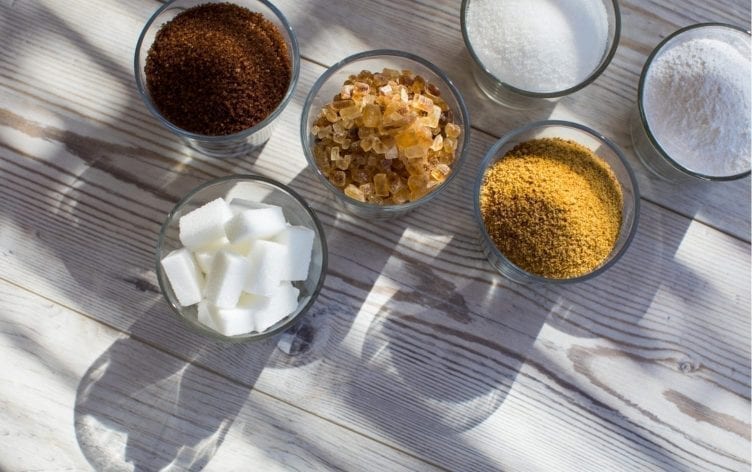
Essential Guide to Sugar

Sugar. This five-letter word is one of the most controversial and talked about topics in nutrition. Everyone seems to have an opinion about this sticky subject. Here are a few things to keep in mind before you go rogue with the sugar dispenser in your morning coffee.
It’s important to distinguish between natural sugar, added sugar and sugar substitutes.
Sugar is a natural component of foods such as fruit, veggies, dairy products and grains. Sugar in these foods is bound in a complicated matrix of nutrients like vitamins, minerals, protein, fat and water.
Added sugar refers to sources of sugar added during processing beyond the level that occurs naturally and includes everything from honey to fruit juice concentrates. Added sugars tend to be energy dense and nutrient-poor. That is, they offer little nutritional value beyond calories and carbohydrates.
Eating too much added sugar is related to poor dietary quality, elevated triglycerides and possibly excess calorie consumption, which contributes to weight gain. Being overweight and obese are risk factors for a number of chronic conditions including heart disease, diabetes and some forms of cancer.
Consuming more calories than you need in any form can be problematic, but consuming a diet rich in sources of naturally occurring sugar like fruit, veggies, whole grains and low-fat dairy does not have the same damaging impact as noshing on too much added sugar. In fact, some of those foods have been shown to buffer your risk of chronic disease.
SUGAR LABEL LINGO
Sugar-Free
Each serving contains less than 1/2 gram of sugar per serving. It can contain artificial sweeteners to boost sweetness.
Low Sugar
No established definition.
Reduced-Sugar
A product contains 25% less sugar compared to the original item with its original serving size.
THE RECOMMENDED DAILY LIMIT OF SUGAR
The American Heart Association recommends limiting added sugar intake to no more than 9 teaspoons (36 grams) of sugar for men and 6 teaspoons (25 grams) of added sugar for women. This is roughly the amount of sugar found in 9–12 ounces of soda or 12–15 large jelly beans. The average American consumes 77 grams of added sugar per day, however, sugar intake appears to be trending downward.
THE BENEFITS OF REDUCING ADDED SUGAR
The relationship between added sugar intake and chronic disease is complex but everyone can probably stand to benefit from a little less sweetness. Even a modest reduction in sugar intake, particularly sugar-sweetened beverages, may offer these benefits:
- Reduce energy intake
- Improved blood glucose control and energy levels
- Lower triglycerides
- Reduced risk of tooth decay and improved dental health
- Improvements in acne
HIDDEN SOURCES OF ADDED SUGAR
Sugar is added to many food products beyond candy, soda, baked goods and cereal. Hidden sources of sugar include:
- Condiments such as BBQ sauce, ketchup, nut butter and jam
- Salad dressing
- Pasta sauce and other simmer sauces
- Processed meat products such as pepperoni, sausages and jerky
- Yogurt
- Crackers
- Bread
- Canned fruit
- Trail mix
- TV dinners
Some packaged products contain a small amount of added sugar, while others contain a lot. The best way to tell if a product is laden with added sugar is to check the ingredient label and list.
WHAT TO KNOW ABOUT HIGH-FRUCTOSE CORN SYRUP
High-fructose corn syrup (HFCS) is a processed corn starch product. It’s made by breaking corn starch molecules into individual glucose molecules and using enzymes to convert some of those glucose molecules into fructose. Fructose is found naturally in fruit and is sometimes referred to as ‘fruit sugar.’
Like other forms of sugar, HFCS is energy dense and provides little satiation or nutrition. HFCS appears to have a similar impact on chronic disease risk as other forms of sugar, however, we still have much to learn about this topic. More specifically, consuming excess fructose has been linked with elevated triglycerides, a risk factor for heart disease.
SUGAR SUBSTITUTES AND SUGAR ALCOHOLS
High-intensity sweeteners like stevia, aspartame and sucralose don’t provide calories and can be several times sweeter than sugar. Their impacts vary depending on the compound, however, recent research suggests they may alter gut bacteria, enhance sweet cravings and contribute to various metabolic disturbances.
Polyols like xylitol, erythritol and sorbitol are another category of sweeteners that fall under the broad heading of sugar substitutes. They contain fewer calories than sugar and are generally less sweet or as sweet sugar. Polyols are FODMAPs, a collection of compounds in food shown to exacerbate gastrointestinal symptoms in some people with IBS.
If you choose to eat sugar substitutes, the best approach is to consume them in moderation to avoid any unpleasant side effects.
ALTERNATIVE NAMES FOR ADDED SUGAR
Added sugar can appear under many different names on the ingredient list such as:
- Glucose, lactose, maltose, fructose, sucrose and other ingredients ending in ‘ose’
- Maple syrup
- Agave syrup
- High-fructose corn syrup
- Corn syrup
- Rice syrup
- Cane syrup
- Invert syrup
- Brown sugar
- Coconut sugar
- Molasses
- Honey
- Fruit juice concentrate
- Dehydrated cane juice
- Corn sweetener
- Coconut sugar
TIPS FOR REDUCING ADDED SUGAR INTAKE
- Swap sugary beverages like soda for water with citrus slices and fresh herbs.
- Save sports drinks for exercise over an hour.
- Substitute flavored yogurt for plain yogurt (preferably Greek-style) and add your own fruit instead.
- Read the label and ingredients list: Sleuth out sources of added sugar. If sugar is one of the first few ingredients listed, the product is probably heavily sweetened.
- Choose canned fruit in natural juice or very light syrup.
- Use sweet condiments in moderation.
- Choose oil and vinegar as a dressing instead of ready-prepared options like honey mustard.
- Save desserts, candy and other sweet treats for special occasions.
- Sweeten dishes with apple sauce or mashed banana instead of sugar or syrup.
BY MYFITNESSPAL
The Arena District Athletic Club is more than just a gym, it’s a premier fitness facility located in the heart of the Arena District in downtown Columbus. We provide convenience and quality, featuring top-of-the-line equipment, top-notch personal trainers, spa-like locker rooms and a wide variety of free group fitness classes daily including Cardio, Spinning, Barre Fusion, Yoga, Boot Camp and more. We offer free 2-hour parking and convenient contract-free memberships, to fit your healthy lifestyle needs. Don’t just join, belong.




